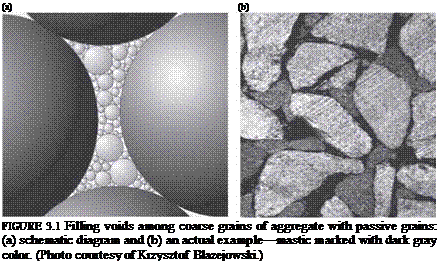FINE AGGREGATE
Throughout this book the term fine aggregate has been conventionally used as a term for the passive aggregate. Its upper limit depends on us—or more specifically, on

the type of coarse grain previously in process of SMA design accepted as a skeleton maker. The task of the fine aggregate is to fill voids among the coarse aggregate particles and facilitate their interlocking, though it is likely to be put the other way round; the fine aggregate cannot disturb interlocking of the coarse aggregates. Such a disturbance can best be illustrated by an example of rounded, uncrushed aggregate (e. g., natural sand or uncrushed gravel) with smooth surfaces that allow the coarse aggregates to glide easily. Introducing such “hard balls” into an SMA mixture causes problems with the stabilization (interlocking) of the aggregate skeleton. That is why in many countries the incorporation of uncrushed aggregates in SMA has been limited to only low volume roads, or its use has been generally banned.
Angularity is a feature that describes the properties of fine aggregates and is typically defined in terms of a flow test, which is an indirect method of angularity measurement. In Europe, the flow coefficient (method EN 933-6) is labeled with the Ecs symbol according to European Standard EN 13043 and describes the time necessary for a standard amount of aggregate to flow out of a suitably shaped vessel through an opening. Obviously the more crushed aggregate with a better microtexture, the longer the flow-out time; that is, rough or angular aggregates tend to lock up and not flow as quickly as smoother particles. Aggregate with an Ecs greater than or equal to 30 or 35 seconds (i. e., Ecs30 or Ecs35 category) is regarded as appropriate for SMA. There are also requirements concerning the angularity of fine aggregate applied in the United States.[10] Tests are carried out in accordance with the American Association of State Highway and Transportation Officials (AASHTO) T 304 Method A (ASTM C1252), and the required fine aggregate angularity (FAA) values are greater than or equal to 45% (NAPA QIS 122). Angularity can also be
measured according to ASTM D3398 and a National Aggregate Association (NAA) test method as well.
Remembering the positive influence of angularity on properties such as deformation resistance, we still have to take into account some negative factors like compaction resistance that accompany an increase in aggregate angularity. Moreover, research conducted by Stakston and Bahia (2003) showed that the effect of FAA depends on the source aggregate and its gradation and that angularity could have an adverse effect on a mixture’s resistance to shearing. Further reading on the influence of FAA on asphalt mixtures can be found in the Stakson and Bahia study or in other papers (Johnson et al., 2004; White et al., 2006).
The content of free voids in a compacted fine aggregate is undoubtedly an essential parameter in SMA volumetric design. This characteristic may be tested through various methods, (e. g., the AASHTO T19 standard). The packing of consecutive SMA ingredients cannot be determined without prior knowledge of this characteristic. That approach to SMA design is discussed in Chapter 7 in the section devoted to U. S. and Dutch design methods.






Leave a reply